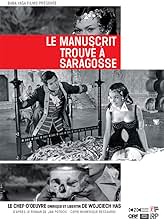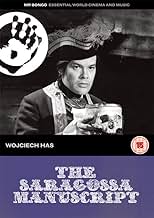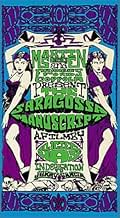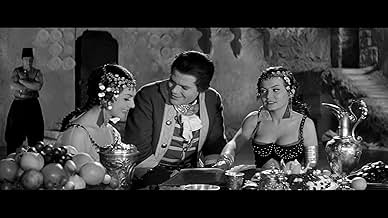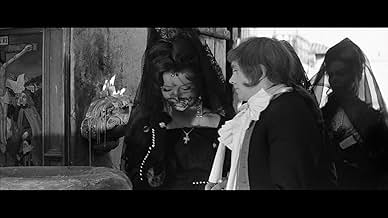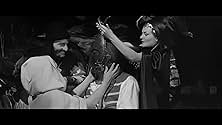Ao encontrar um livro que conta a história de seu avô, um oficial se aventura pela Espanha conhecendo uma ampla gama de personagens, a maioria dos quais tem sua própria história para contar.Ao encontrar um livro que conta a história de seu avô, um oficial se aventura pela Espanha conhecendo uma ampla gama de personagens, a maioria dos quais tem sua própria história para contar.Ao encontrar um livro que conta a história de seu avô, um oficial se aventura pela Espanha conhecendo uma ampla gama de personagens, a maioria dos quais tem sua própria história para contar.
- Direção
- Roteiristas
- Artistas
- Prêmios
- 1 vitória no total
- Direção
- Roteiristas
- Elenco e equipe completos
- Produção, bilheteria e muito mais no IMDbPro
Avaliações em destaque
Its story centers around the efforts by a brave officer in mid-XVIIIth Century Spain to distance himself from ghosts or evil spirits that visit him every night and take the form of two charming Muslim sisters who want to be his lovers and bear his children, even in succubi form, and insist that he convert to Islam. Those erotic (and heretic) reveries also have something to do with devilry and all things forbidden and his encounters with those women are encouraged by the mysterious figure of the Cabalist (another forbidden science) and his sister Rebecca and severely repressed by roaming members of the Catholic Inquisition. This framing story is the pretext for a series of very involving and amusing moral tales told in flashback by several participants, who all echo each other and whose moral seems to be that all religious and social prohibitions and ghost stories should be taken with a grain of salt. In this ocean of mystery and gothicism stands the figure of Don Pedro Velasquez, a mathematician who befriends the hero and who seems the only character to believe in the cold light of reason (foreshadowings of Polanski's "The Fearless Vampire Killers").
After several viewings, the only point in the film which remains mysterious is why Frasqueta's lover (Pena Flor) should appear with a bloodied face when he climbs in her bedroom through a window, a fact the viewer has to provide his own backstory for and which could be evidence that the original film was even longer than the 182 minutes at which it clocks in on the restored DVD edition. (Personal theory: Pena Flor really was Frasqueta's lover and the band of thugs Frasqueta hired to deceive her husband into believing he had paid to have his wife's lover killed really did attempt to kill him before he paid them to kill her husband instead.) Well, that and the fact that Jerry Garcia of the Grateful Dead, an early fan of the film and one the persons responsible for its restoration, was fond of quoting a scene from the film that doesn't seem to exist anymore (a character's confrontation with Death at the foot of his bed, which, according to DVD Savant, could come from the 1960 Mexican film "Macario")...
A WORD ABOUT THE DVD: This film was restored thanks to the efforts and money of Martin Scorsese, Francis Ford Coppola and the above-mentioned Jerry Garcia, and the collaboration of the director. It was shot in Dyaliscope, the French CinemaScope equivalent, which is always projected at a standard 2.35:1 ratio. This "enhanced for widescreen TVs" DVD shows an image with a ratio of 2:1, which means that the picture information is still squeezed by a ratio of 15 % in relation to the way it should be shown normally. In this presentation, the picture is "fish-eyed" and the characters and animals appear too slim. There is no way around this problem if you watch it on a 4:3 television set. However, if you own a widescreen TV, you can set-up your DVD player as for a standard 4:3 TV monitor and gently unsqueeze the resulting picture with any one of the "cheater" modes provided by your TV model to approximate a 2:35 presentation. There is no way of knowing if this drawback is the result of simple ignorance (mistaking the 2:1 squeeze of Dyaliscope with a 2:1 projection ratio) or of a compromise allowing to use the greater part of the TV screen in both 4:3 and 1.77:1 TV sets. It took me along time to figure out this problem and I am glad to share this little trick with you.
During the Napoleonic wars in Spain, two soldiers from opposing sides become fascinated by the same object. A French officer finds a manuscript on the second floor of a tavern, but the town is soon captured by the Spanish. The Spaniard, seeing the importance of the tome, translates it to the Frenchman who is unable to read the book as it is written in Spanish. The book describes the adventures of one of the Spaniard's ancestors, Alfonse Van Worden (Zbigniew Cybulski). Humorously, when the Spanish troops tell their commander "we are being surrounded" he only tells them "close the door, you are letting in a draft." Alfonse Van Worden is trying to pass the Sierra Morena Mountains of Spain in the 18th century on his way to Madrid. But his passage is no simple task, as ghosts, gypsies and inquisitors complicate his voyage. On the hillside is an inn that is cared for by people who too afraid to spend the night there themselves. Van Worden disregards the superstitious people, only to be taken to a basement of the inn by a mysterious woman. In the basement, he meets two beautiful Moorish princesses that want him to be their husband, but quickly make him drink from a chalice made from a human skull. He wakes up on the hillside some distance from the inn near two hanging men with many skulls strewn about the ground.
When Van Worden wakes up, he makes his best effort to continue to Madrid, but ends up meeting a number of people and is always delayed. The people he meets tell him their story, and the people in the story tell their story also. Like a nesting egg, the movie becomes a story in a story in a story. The stories interlink and overlap, each filling us in with details the others where not aware of. While it nearly resembles a horror with creepy ghosts and ghouls, the story is also amusing and funny with curious tales of exploits and adventures. The Saragossa Manuscript also has en erotic side with gorgeous women at every turn. While parts of the story resemble a horror, the rest is like a romance or even a comedy. The Saragossa Manuscript is a sophisticated film brimming with mystical and occult elements.
Você sabia?
- CuriosidadesLuis Buñuel, who seldom viewed movies more than once, liked this film so much that he saw it three times.
- Citações
Donna Rebecca Uzeda: All these adventures begin simply. The listener thinks it'll soon be over, but one story creates another, and then another.
Don Pedro Velasquez: Something like quotients which can be divided infinitely.
- Versões alternativasOriginally released in a cut version in the US, the film was restored to it's original 182-minutes running time and premiered at the New York Film Festival in September 1997. The restoration project, supervised by Edith Kramer, was initially sponsored by Grateful Dead's leader Jerry Garcia and later completed by Francis Ford Coppola and Martin Scorsese. The restored version includes a dedication to Jerry Garcia.
Principais escolhas
- How long is The Saragossa Manuscript?Fornecido pela Alexa
Detalhes
- Data de lançamento
- País de origem
- Central de atendimento oficial
- Idioma
- Também conhecido como
- The Saragossa Manuscript
- Locações de filme
- Olsztyn, Slaskie, Polônia(castle)
- Empresa de produção
- Consulte mais créditos da empresa na IMDbPro
Bilheteria
- Faturamento bruto mundial
- US$ 13.377
- Tempo de duração3 horas 2 minutos
- Cor
- Mixagem de som
- Proporção
- 2.35 : 1
Contribua para esta página


